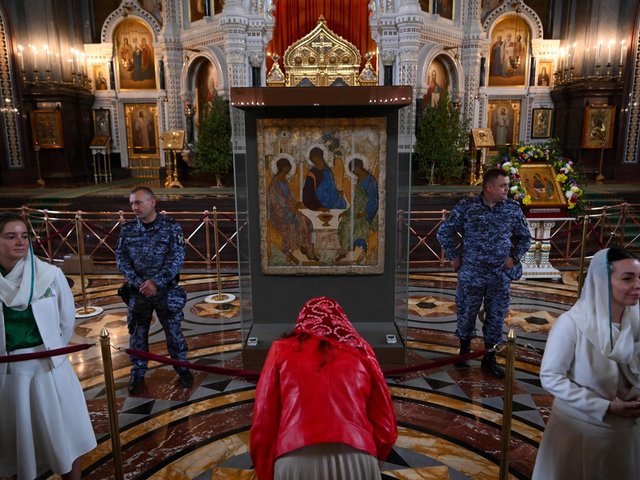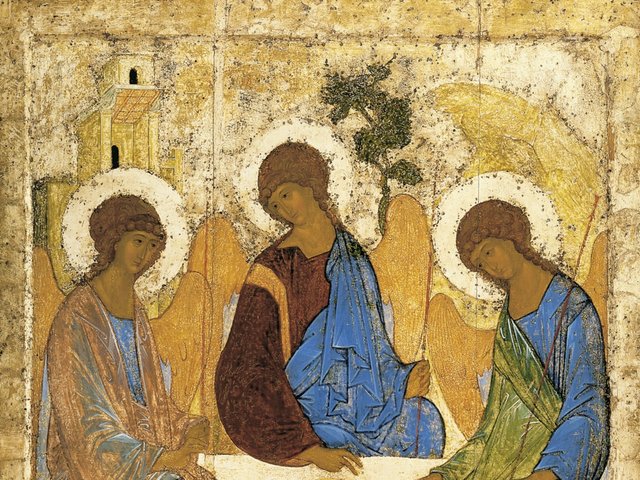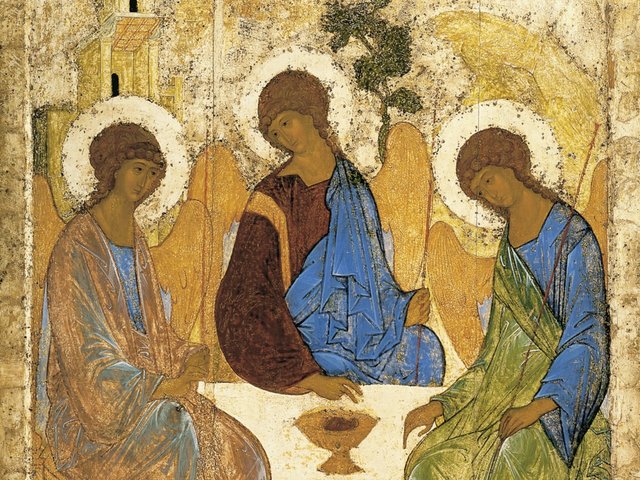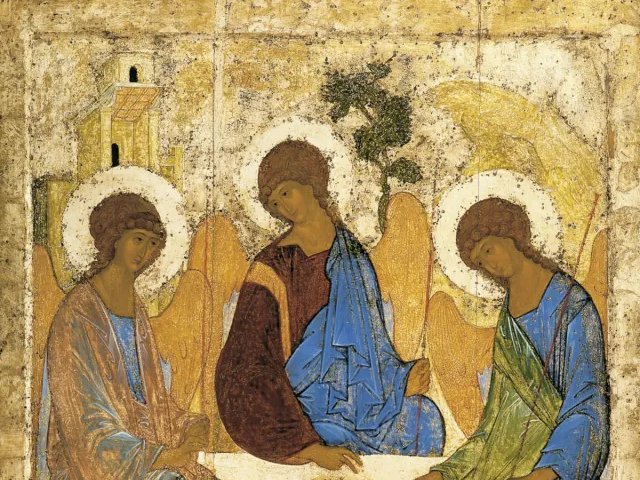A religious painting depicting a Russian soldier bandaging a Ukrainian soldier has been spotted in a monastery in northwestern Russia. The work appeared in a state television report about Russian President Vladimir Putin hosting his Belarusian counterpart at the Valaam Monastery on Lake Ladoga, in Karelia.
Putin and Alyaksandr Lukashenka [often spelled Lukashenko] have been holding annual summer meetings at the monastery over recent years. Valaam, destroyed under the Soviets but reactivated in 1989, is one of the most important spiritual sites of the Russian Orthodox Church, which, under the leadership of Patriarch Kirill I, has actively supported the country’s full-scale invasion of Ukraine. Dissident priests have been defrocked, some imprisoned or forced out of Russia.
Video footage released by the Kremlin and Lukashenka’s office shows the leaders meeting on 1 August, being greeted by a black-robed monk, then appearing in a chapel at the monastery called the Smolensk Skete. The monk is shown, while surrounded by frescoes of historic military scenes, speaking of Russia’s great sacrifices in the First and Second World Wars. Afterwards Putin and Lukashenka told reporters about plans to deploy Russian Oreshnik missiles in Belarus, which served as a staging ground for Russia’s 2022 invasion and borders Poland. Putin has previously used the deployment of the missiles to threaten Ukraine’s allies in Nato, with which Russia has tense relations.
The television report, broadcast on the channel Rossiya 1, hovers over apicture hanging in a separate wooden chapel dedicated to the former tsar Nicholas II and his family, who are canonised as saints in the Russian Orthodox Church. It shows a Russian soldier bandaging a Ukrainian soldier, with both looking towards a “The Saviour Not Made by Hands” banner—a canonical depiction of Christ that has become popular with the Russian military. The Russian soldier’s uniform has the “Z” symbol , which has been used as a propaganda symbol by the Russian military and state during the war.
Rossiya 1 presented the picture as a new feature of the chapel, but the head of the Smolensk Skete Hieromonk David told Argumenty i Fakty, a government-controlled weekly, that Valaam monks probably painted it in March 2022, shortly after Putin announced Russia’s “special military operation”.
Putin claims that Russians and Ukrainians are one nation forcibly divided by the West, and Hieromonk David’s interpretation of the mural appears to align with this view.
"I know of several cases when brothers found themselves on different sides of the barricades,” Hieromonk David told Argumenty i Fakty. “There are two warriors in the picture. One is supporting, hugging and bandaging the head of the other. This is a symbolic wound: the head—a way of thinking—is wounded. These brothers are not looking at each other, they are looking in one direction, which they have chosen together, and they are looking at the ancient Russian banner, the flag on which the Saviour Not Made by Hands is depicted, and they find common values that under one God, with one Orthodox faith, with one history, with one blood, they are brothers.”
A contrasting reality
Roman Sheremeta, a Ukrainian-American economist at Case Western Reserve University in Ohio—who is known for his social media commentary about the war—explained in a post that the scene depicted in the icon is a far cry from reality.
“In reality, Russian soldiers do not provide medical aid to Ukrainians — they execute them, behead them, castrate them and torture them,” he wrote on Facebook on 4 August.
Andrei Kordochkin, a priest and activist based in Europe who was forced out of the Russian Orthodox Church for speaking out against the full-scale invasion, tells The Art Newspaper that the Russian state’s goal in promoting the Valaam image is part of an ongoing effort to draw the events—and ideals—of the Soviet regime “into the sacred space and thus to sacralise them”. The image of the soldiers corresponds to tsarist, Soviet and Putin-era ideology that positions Ukraine as being part of a single, Russian empire.
Kordochkin, who is a founder of Peace Unto All, an organisation that helps anti-war clergy, points to another example of Soviet ideas being celebrated in a religious setting: a church built over 20 years ago in Nizhny Tagil, Russia. The church, dedicated to the 14th-century warrior saint Dmitry Donskoy, was established next to the tank factory Uralvagonzavod, which armed the Soviet Union during the Second World War and has been doing the same for Russia during its invasion of Ukraine. Inside the church is a fresco depicting a tank in front of the destroyed Nazi Reichstag, with Donskoy and his cavalry hovering in the sky.
A Russian military church built in Patriot Park near Moscow shortly before the full-scale invasion, meanwhile, glorifies Russian military victories in its iconography and architecture.






